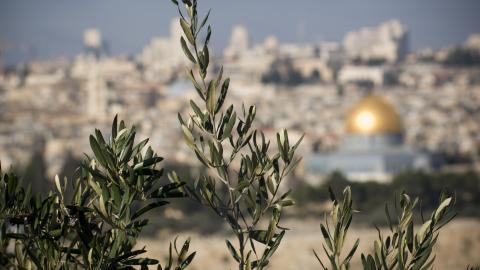Driving with friends along Israel’s sun-drenched border with Lebanon was a fascinating way to begin my latest visit to the Jewish State. And, fortunately, on that bright mid-August day, it felt like a perfectly calm and serene outing. It was, for me, an opportunity to see that northernmost edge of Israel, which I had never visited during the decade I lived in Jerusalem. In fact, I had first moved to Jerusalem during the 2006 Lebanon War. And tensions and conflicts with that northern neighbor — and specifically with its Hezbollah terrorist organization — have never really subsided since.
Even those few days ago, we knew that our little outing wasn’t without risks. In fact, I found that just days later, a Hezbollah operative had hurled a Molotov cocktail into the Israeli border town of Metulla, not far from where we traveled. The Times of Israel reported:
“In recent months, Hezbollah activity has repeatedly been spotted along the border, in incidents that Israel sees as deliberate provocations, including the erection of two tents on the Israeli side of the United Nations-recognized Blue Line in the Mount Dov area. The Iran-backed group later took down one of the tents, while threatening to attack if Israel moves to dismantle the other one.”
Less than a month before that, a number of Lebanese suspects had attempted to sabotage the security fence in the area. According to al Jazeera, “Three Hezbollah members were wounded by Israeli fire near the border, a security source reported on the condition of anonymity.”
More recently, on August 16, the United States announced that it was sanctioning a Lebanese “environmental organization,” Green Without Borders (GWB), for allowing Hezbollah to use their so-called environmental sites “to conduct weapons training while providing support for Hezbollah activities along the Blue Line [the border].” Meanwhile, GWB has also reportedly permitted Hezbollah to use its outposts for underground warehouses and munitions storage tunnels.
All of this reflects Hezbollah’s increasingly hostile declarations about the Jewish State, which include threats by the terror group’s loquacious ringleader Hassan Nasrallah, warning of incursions into Israel. Nasrallah continues to point out Israel’s “weakness” amidst its current internal political conflicts while cautioning it against an attack inside Lebanon. His not-very-impressive threats to “Send Israel back to the Stone Age” seem to reflect his most heartfelt sentiments.
Some well-informed friends of mine believe that armed conflict between Lebanon and Israel will likely flare up sooner rather than later — and not because either country will formally declare war on the other. In fact, as General Assaf Orion of the Institute for National Security Studies at Tel Aviv University warns:
“Two war machines are now deployed on the ground, ours and theirs. … One needn’t be surprised that their militants are approaching the border with firearms. … Whether war breaks out is no longer decided from the high ranks. It depends on how accurate the [Hezbollah] antitank unit is in firing missiles at the IDF, and on how many casualties it causes. … It’s possible to be dragged into a war, even if that’s not what you want.
Heading south from Israel and Lebanon’s deceptively picturesque and (usually) peaceable-looking border, my friends and I stopped for an Arab lunch, which was by then both welcome and delicious. And I was soon welcomed into the beautiful home of friends, overlooking the sapphire Sea of Galilee, where any thoughts of conflict were quickly erased.
Beyond that lovely spot, however, today’s Israel seems beset by multiple tensions and turmoil — both from inside and outside the country. This became evident to me during the few days I later spent in Jerusalem. Protestors bearing Israeli flags — both for and against the current Netanyahu government — chanted, marched, and snarled traffic. News reports exposed deep political fissures regarding both national and international issues. To make matters worse, terrorism against Israelis has increased dramatically. On August 21 The Jerusalem Post reported:
“Thirty-four people have been murdered in terrorist attacks in Israel so far this year, making it one of the deadliest years since the Second Intifada. … After Monday’s attack, Israel has now seen an average of one person murdered in a terrorist attack per week, with the first taking place at the end of January and at least one being carried out every month this year.”
Toward the end of my trip, I sat with another good friend at a Jerusalem restaurant perched high on the Mount of Olives with a spectacular view of the city — in fact the restaurant is aptly named “City View.” By that time, the Lebanon border felt like it was a million miles away. Gaza was much closer, with its own rocket array poised for another test of Iron Dome’s life-saving defense system. Yet still, as wide and clear the overview of Jerusalem was, there was no way to foresee what might appear next — a stunning Holy City sunset, a sudden explosion, or an unexpected choir of heavenly angels. Nobody really knows.
Such is life in the wonderful, turbulent, and incomparable Jewish State. Today’s Jerusalem is a miracle of both ancient and modern history. And today’s nation of Israel is clearly the fulfillment of ancient prophecies, while also at the center of seething conflict and continuous violence. Both realities should be kept in mind as we focus upon our daily prayers for our biblical obligation: “Pray for the peace of Jerusalem.” Let’s remember to pray for her, for all who love her, and for those who dwell within Israel’s peaceful-looking but ever-disputed borders.


















